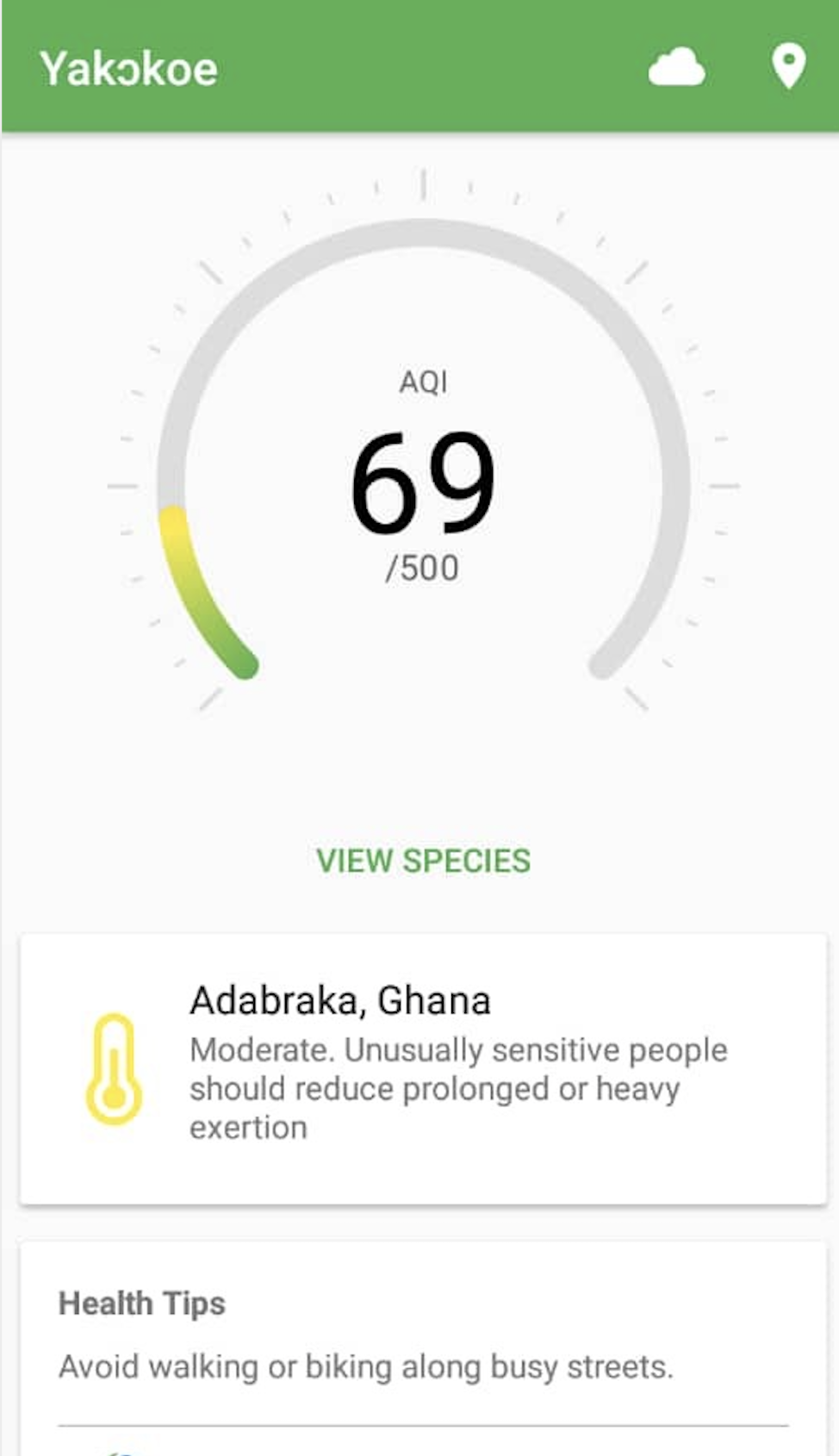Engaging citizens in Sub Saharan Africa on air quality for improved public health and environmental sustainability
17/09/2019

Air pollution according to the United Nations kills 800 people every hour around the globe1 and majority of these deaths occur in low and middle income countries specifically Africa and Asia2. Addressing the deteriorating air quality in Ghana and many parts of sub-Saharan Africa however is challenging3 due to data gaps as a result of limited air quality monitoring stations in Ghana and many parts of Sub-Saharan Africa(SSA)4. Further to this, the available scanty air quality data is poorly communicated and only found in governmental reports5 which are difficult to access. Consequently, citizens are not able to make informed decisions and to plan their daily activities to avoid/ limit exposure to atmospheric emissions.
In recent years, advancement in environmental sensing technology offers the opportunity to undertake air quality monitoring with miniaturized low-cost tools in environments previously difficult to monitor for example in Ghana and wider SSA. Most of these commercially available low-cost tools are robust, user-friendly, rely on low-power supply, able to collect fast and in near real-time high resolution in-situ data and do not require huge infrastructure6,7.
Though there are published and ongoing studies to improve the quality of data that these devices acquire, the capability of low-cost tools to collect high spatiotemporal data offers governmental agencies, civil society organizations and interested stakeholders to develop new approaches in communicating air quality data to the general public in SSA and similar environments. This in part is due to the ability of these devices to use inbuilt general packet radio service / internet connectivity to transmit populated data onto internet based platforms. These innovative approaches will enable responsible agencies and civil society organizations to engage, educate and empower citizens on air quality and its impact on human health. This will in the long-term ease the work of the responsible agencies to develop and implement air pollution mitigation policies as well as integrate behavioral changes with air quality monitoring in such environments.
Clean Air One Atmosphere (CAOA), a Ghanaian based non-profit is piloting such a concept to democratize air quality monitoring in Ghana and potentially wider SSA. Currently, CAOA feeds on user-friendly and accessible open source data from the Purpleair map and meaningfully communicate it using the USAQI via the android mobile application Yakokoe. Yakokoe updates subscribers on air quality levels in near real-time based on geographical locations of sensor installations. Advices are given to subscribers based on the air quality levels and some information on basic actionable steps that individuals can engage in to both reduce exposure to and reduce atmospheric pollution.
CAOA hope to establish a dense network of such and/ or low-cost sensors firstly in Accra to inform decision-making and extend this project to other parts of Ghana and SSA. Currently, Yakokoe covered sensor locations not only in Ghana but South Africa, Democratic Republic of Congo, Angola, Nigeria, The Gambia, Sierra Leone and Algeria. Yakokoe is currently run as a prototype and at a pilot phase. It forms part of Collins’ PhD studies and a form of knowledge transfer as well as conceptualizing his research work. Yakokoe can be downloaded from the google play store via this link https://play.google.com/store/apps/details?id=com.cleanairghana.yakokoe&hl=en

Yakokoe is a movement to revolutionize air quality monitoring in Ghana and wider SSA. Join us by following our twitter or liking Facebook handles @CleanAir1ATM.
1http://funnycor.com/detail?newsId=1942426 (accessed 12 June 2019)
Health Effects Institute. 2019. State of Global Air 2018 Special Report. Boston, MA: Health Effects Institute
2http://challengingheights.org/wp-content/uploads/2014/10/National_Analytical_Report2010.pdf, accessed 27/02/2019
3Amegah, A.K., Agyei-Mensah, S., n.d. Urban air pollution in Sub-Saharan Africa: Time for action. Environ. Pollut. doi:10.1016/j. envpol.2016.09.042
4Petkova, E.P., Jack, D.W., Volavka-Close, N.H., Kinney, P.L., 2013. Particulate matter pollution in African cities. Air Qual. Atmosphere Health 6, 603–614. doi:10.1007/s11869-013-0199-6
5Schwela, D., 2012a. Review of urban air quality in Sub-Saharan Africa region - air quality profile of SSA countries (No. 67794). The World Bank
6Mead, M.I., Popoola, O.A.M., Stewart, G.B., Landshoff, P., Calleja, M., Hayes, M., Baldovi, J.J., McLeod, M.W., Hodgson, T.F., Dicks, J., Lewis, A., Cohen, J., Baron, R., Saffell, J.R., Jones, R.L., 2013. The use of electrochemical sensors for monitoring urban air quality in low-cost, high-density networks. Atmos. Environ. 70, 186–203. doi:10.1016/j.atmosenv.2012.11.060
7Snyder, E.G., Watkins, T.H., Solomon, P.A., Thoma, E.D., Williams, R.W., Hagler, G.S.W., Shelow, D., Hindin, D.A., Kilaru, V.J., Preuss, P.W., 2013. The changing paradigm of air pollution monitoring. Environ. Sci. Technol. 47, 11369-11377
Categories & Tags:
Leave a comment on this post:
You might also like…
Preparing your work for Turnitin submission
Before submitting your work into Turnitin for similarity checking, if you have used referencing software then you may need to take some important steps first. Mendeley and Zotero integrate with MS Word by embedding field ...
The fast track to supercar engineering: My Cranfield journey
It’s been a dream come true to work on some of the world’s most prestigious supercars – the Aston Martin Valhalla, McLaren 750 & Artura, the GMA T.33. But every successful ...
Automotive Engineering: From student to hypercar innovation at Rimac
We sat down with recent graduate Thomas Perrin, to discuss how his year on the MSc in Automotive Engineering at Cranfield University propelled him from the lecture hall directly into the ...
What this year at Cranfield really meant to me
Every Cranfield journey is unique. In this alumni reflection, Zachea Scicluna shares what her year at Cranfield truly meant, from facing uncertainty to gaining hands-on experience in industry-backed projects. I’ve been reflecting (and delaying) ...
Preparing for assignments and exams?
Sorry! We know it seems a bit mean to mention the exams in January rather than looking forward to the break before it! However, we know many of you will be thinking about your forthcoming ...
Screening for FTSE 100 companies on Bloomberg
So you’re researching an index and need some data on its constituent companies? Bloomberg’s Equity Screening tool makes light work of this, not just for the FTSE, but for indices, exchanges and sectors worldwide. Type EQS ...






